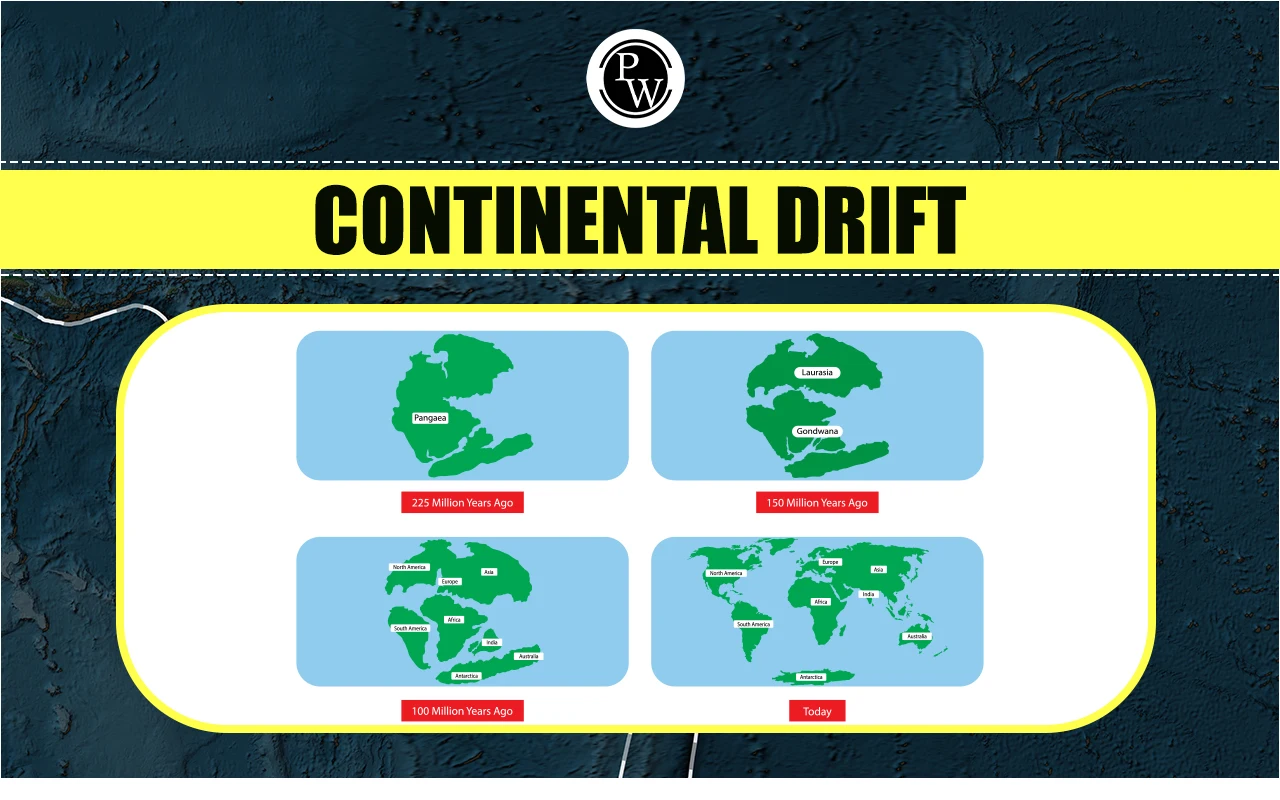
Continental Drift
Continental drift is a geological theory that explains the movement of Earth's continents over geological time. Proposed by Alfred Wegener in the early 20th century, it suggests that continents were once joined together in a single landmass called Pangaea and have since drifted apart. Continental Drift theory laid the groundwork for modern understanding of plate tectonics. In this article we will look into the history, evidence, mechanisms, and implications of continental drift in a simplified manner.History of Continental Drift Theory
Alfred Wegener's Proposal: In 1912, German meteorologist and geophysicist Alfred Wegener proposed the theory of continental drift. Alfred observed that coastlines of South America and Africa seemed to fit together like pieces of a jigsaw puzzle. He hypothesized that these continents were once part of a supercontinent called Pangaea, which existed around 300 million years ago.
Initial Reception: Wegener's ideas were controversial and initially met with skepticism. Many geologists rejected his theory because he couldn't provide a convincing mechanism for how continents could move. Despite this, Wegener's hypothesis sparked further research and debate in the geological community.

Evidence for Continental Drift
Fit of the Continents: One of the most striking pieces of evidence for continental drift is the apparent fit of the continents.
Fossil Evidence: Identical fossils of plants and animals have been found on continents that are now widely separated by oceans. For instance, fossils of the extinct reptile Mesosaurus have been discovered in both South America and Africa, suggesting that these continents were once connected.
Geological Evidence: Similar rock formations and mountain ranges are found on continents that are now far apart. For example, the Appalachian Mountains in North America are geologically similar to the Caledonian Mountains in Scotland and Scandinavia, indicating that they were once part of the same mountain range.
Paleoclimatic Evidence: Evidence of past climates also supports continental drift. For example, glacial deposits and striations (scratches on rocks caused by glacial movement) found in India, South Africa, and South America suggest that these regions were once part of a single, connected landmass located near the South Pole.
Distribution of Earthquakes and Volcanoes: The global distribution of earthquakes and volcanoes aligns with the boundaries of tectonic plates, which supports the idea that continents and ocean floors are part of a dynamic system of moving plates.
Mechanism of Continental Drift
Plate Tectonics: The theory of plate tectonics, developed in the mid-20th century, provided a mechanism for continental drift. According to this theory, Earth's lithosphere is divided into several large and small plates that float on the semi-fluid asthenosphere. These plates move due to convection currents in the mantle caused by the heat from Earth's core.
Types of Plate Boundaries
Divergent Boundaries: At divergent boundaries, plates move away from each other. This movement creates new crust as magma rises from the mantle and solidifies, forming mid-ocean ridges and rift valleys. An example is the Mid-Atlantic Ridge, where the Eurasian and North American plates are moving apart.
Convergent Boundaries: At convergent boundaries, plates move towards each other. This can result in subduction, where one plate is forced under another, leading to the formation of mountain ranges, volcanic arcs, and oceanic trenches. The collision between the Indian Plate and the Eurasian Plate, which formed the Himalayas, is a prime example.
Transform Boundaries: At transform boundaries, plates slide past each other horizontally. This movement causes earthquakes along faults, such as the San Andreas Fault in California.
Implications of Continental Drift
Formation of Supercontinents: The concept of continental drift suggests that the Earth's continents have repeatedly come together and broken apart over geological time, forming supercontinents like Pangaea. This cyclical process, known as the supercontinent cycle, has significant implications for Earth's geology, climate, and biological evolution.
Mountain Building: The movement of tectonic plates leads to the formation of mountain ranges through processes such as folding, faulting, and volcanic activity. The collision of continental plates can create extensive mountain belts, such as the Himalayas, the Andes, and the Alps.
Earthquakes and Volcanoes: Continental drift and plate tectonics are responsible for most of the Earth's seismic and volcanic activity. Earthquakes occur mainly along plate boundaries due to the release of stress accumulated from plate movements. Volcanic activity is common at divergent and convergent boundaries, where magma from the mantle reaches the surface.
Distribution of Fossils and Minerals: Continental drift has influenced the distribution of fossils and minerals around the world. The breakup and movement of continents have caused the dispersion of species and the formation of various mineral deposits in different regions.
Climate Changes: The movement of continents affects global climate patterns by altering ocean currents, atmospheric circulation, and the distribution of land and sea. For example, the formation of the Isthmus of Panama changed ocean circulation and had a significant impact on global climate.
Modern Evidence and Techniques
Seafloor Spreading: The discovery of seafloor spreading in the 1960s provided strong evidence for continental drift. As new oceanic crust forms at mid-ocean ridges and spreads outwards, it pushes the continents apart. This process is supported by the symmetrical patterns of magnetic stripes on either side of mid-ocean ridges, which record the history of Earth's magnetic field reversals.
GPS Measurements: Modern technology, such as Global Positioning System (GPS) measurements, allows scientists to directly observe and measure the movement of tectonic plates. These measurements confirm that plates move at rates of a few centimeters per year, consistent with the theory of plate tectonics.
Earthquake and Volcanic Activity Monitoring: The distribution and frequency of earthquakes and volcanic eruptions provide real-time evidence of plate tectonics. Seismic and volcanic activity is concentrated along plate boundaries, highlighting the dynamic nature of Earth's crust.
Deep-Sea Drilling: Deep-sea drilling programs have provided valuable data on the age and composition of oceanic crust. Samples collected from the seafloor show that the age of the oceanic crust increases with distance from mid-ocean ridges, supporting the concept of seafloor spreading and plate tectonics.
To succeed in upcoming exams, candidates should consider exploring PW SSC Books We provide high-quality content at an affordable price, including sample papers, mock tests, guidance sessions, and more to ensure aspirants secure their selection. Also, enroll today on SSC Online Coaching to turn your dreams into reality.Continental Drift FAQs
1. What is continental drift?
2. Who proposed the theory of continental drift?
3. What evidence supports continental drift?
4. How does continental drift occur?










